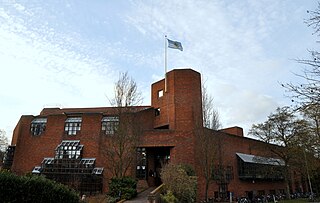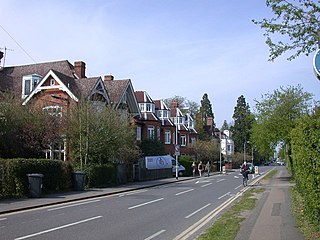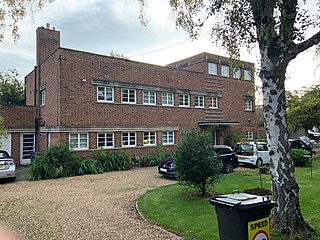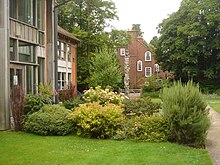
Alfred Marshall was an English economist, and was one of the most influential economists of his time. His book Principles of Economics (1890) was the dominant economic textbook in England for many years. It brought the ideas of supply and demand, marginal utility, and costs of production into a coherent whole. He is known as one of the founders of neoclassical economics.

Coton is a small village and civil parish about three miles west of Cambridge in Cambridgeshire, England and about the same distance east of the Prime Meridian. It is in the district of South Cambridgeshire. The parish covers an area of 392 hectares. In the 2001 census it had a population of 773, with approximately 336 dwellings and 322 households. The population at the 2011 census was 910.

Robinson College is a constituent college of the University of Cambridge. Founded in 1977, it is one of the newest Oxbridge colleges and is unique in having been intended, from its inception, for both undergraduate and graduate students of both sexes.

Hughes Hall is a constituent college of the University of Cambridge in England. It is the oldest of the University of Cambridge's postgraduate colleges. The college also admits undergraduates, though undergraduates admitted by the college must be aged 21 or over. There is no age requirement for postgraduate students. The majority of Hughes Hall students are postgraduate, although nearly one-fifth of the student population comprises individuals aged 21 and above who are studying undergraduate degree courses at the university.

Queens' College is a constituent college of the University of Cambridge. Queens' is one of the older colleges of the university, founded in 1448 by Margaret of Anjou. Its buildings span the River Cam with the Mathematical Bridge and Silver Street connecting the two sides.

Lucy Cavendish College is a constituent college of the University of Cambridge.

Newnham is a suburb of the city of Cambridge in England. Historically, the name refers to a hamlet centred on a mill on the River Cam, a short distance to the southwest of the city centre. The modern council ward of Newnham covers much of the west of the city. Several Cambridge University colleges are situated in this ward, including Newnham, Wolfson, Robinson, Selwyn and Darwin. In modern times Newnham has become one of the most affluent areas of Cambridge and sometimes features in national quality of life surveys.

Mary Marshall was an economist who in 1874 had been one of the first women to take the Tripos examination at Cambridge University – although, as a woman, she had been excluded from receiving a degree. She was one of a group of five women who were the first to be admitted to study at Newnham College, the second women's college to be founded at the University.
Christopher Catherwood, is a British author based in Cambridge, England and, often, in Richmond, Virginia. He has taught for the Institute of Continuing Education based a few miles away in Madingley and has taught for many years for the School of Continuing Education at the University of Richmond. He has been associated each summer with the University of Richmond's History Department, where he is its annual summer Writer in Residence, and where most of his recent books have been written.
John James StevensonFRSE FSA FRIBA, usually referred to as J. J. Stevenson, was a British architect of the late-Victorian era. Born in Glasgow, he worked in Glasgow, Edinburgh and London. He is particularly associated with the British Queen Anne revival style.

The New Museums Site is a major site of the University of Cambridge, located on Pembroke Street and Free School Lane, sandwiched between Corpus Christi College, Pembroke College and Lion Yard. Its postcode is CB2 3QH. The smaller and older of two university city-centre science sites, the New Museums Site houses many of the university's science departments and lecture theatres, as well as two museums.

Madingley Road is a major arterial road linking central Cambridge, England with Junction 13 of the M11 motorway. It passes by West Cambridge, a major new site where some University of Cambridge departments are being relocated.

Grange Road is a street in Cambridge, England. It stretches north–south, meeting Madingley Road (A1303) at a T-junction to the north and Barton Road (A603) to the south. It runs approximately parallel with the River Cam to the east. Grange Road is almost one mile long and has 17th century origins. It contains several colleges of the University of Cambridge.

Queen's Road is a major road to the west of central Cambridge, England. It links with Madingley Road and Northampton Street to the north with Sidgwick Avenue, Newnham Road and Silver Street to the south.

Northampton Street is a street in the north of central Cambridge, England. It runs between Madingley Road and Queen's Road to the west and Castle Street, by Castle Hill, Chesterton Lane, and Magdalene Street to the east.

Storey's Way is a mainly residential road, approximately 650 metres to the west of the city centre in Cambridge, England. It falls within the Castle Electoral Ward of Cambridge City Council, and feeds on to the major arterial roads Huntingdon Road to the north and Madingley Road to the west.

31 Madingley Road is a Modernist red-brick house in Madingley Road, west Cambridge, England, designed by Marshall Sisson for the classical archaeologist A. W. Lawrence in 1931–32. It is one of the first Modernist-style houses in Cambridge, and is listed at grade II.

Wilberforce Road is a street in the western outskirts of Cambridge, England, which runs north–south for 550 metres, connecting Madingley Road with Adams Road, which runs eastwards to Grange Road. The road was built in 1933, although several of its buildings date from earlier in the 20th century. It was named for William Wilberforce, the anti-slavery campaigner. Wilberforce Road falls within the conservation area of West Cambridge. As of 2022, the usage is a mix of private housing and buildings and sports facilities associated with the university and colleges, including the Centre for Mathematical Sciences. There are two listed buildings, Emmanuel College's sports pavilion (1910) and the Modernist-style number 9 (1936–37).


















